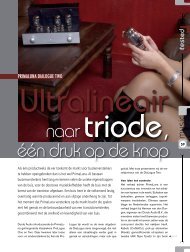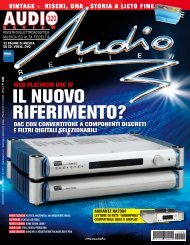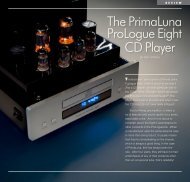Audia Flight PRE Page 1 of 7 Dagogo - Durob Audio
Audia Flight PRE Page 1 of 7 Dagogo - Durob Audio
Audia Flight PRE Page 1 of 7 Dagogo - Durob Audio
You also want an ePaper? Increase the reach of your titles
YUMPU automatically turns print PDFs into web optimized ePapers that Google loves.
<strong>Dagogo</strong> Review: <strong>Audia</strong> <strong>Flight</strong> <strong>PRE</strong><br />
categories, there are polarities in approach and technology – such as the RIAA-based phonograph and<br />
the 16-bit/44.1kHz-based digital playback systems, MOSFET and tube-based amplifications, and<br />
finally,<br />
cone and planar loudspeaker technologies – that the proponents for each consider indispensable and<br />
superior. Yet, there is one component type that everyone has contemplated getting rid <strong>of</strong> one way or<br />
the<br />
other, and it is the preamplifier.<br />
Transistor or tube, line preamplifiers have always occupied a bittersweet spot in everyone’s heart,<br />
considering its property for either making or breaking a system from the level <strong>of</strong> synergy created. To<br />
many<br />
audiophiles, brackets <strong>of</strong> price range represent a safe route for matching components: budget<br />
components<br />
dominate the sub-$2,000 range, while high-performance ones reside in the $9k+; and any higher would<br />
be<br />
considered exotic by many.<br />
<strong>Audio</strong>philes contemplating the purchase <strong>of</strong> either $2,000 or $50,000 line preamplifiers have an easier<br />
time than those <strong>of</strong> us considering a $7k one, for the polarity in prices provides clarity and guideline in<br />
respective buyers’ decision-making process, at the same time represent an approximate indicator for<br />
system matching; while a $7,000 line preamplifier falls into a somewhat grayish area.<br />
If one has a $10,000 power amplifier <strong>of</strong> commendable performance, then a $20,000 preamp <strong>of</strong><br />
competent<br />
caliber may continue to compliment the power amplifier’s inherent strength. However, a $7k<br />
preamplifier<br />
would likely accentuate the relative weakness <strong>of</strong> a $3,000 power amplifier that was designed to a<br />
budget,<br />
<strong>Page</strong> 2 <strong>of</strong> 7<br />
The <strong>PRE</strong> is one <strong>of</strong> a kind in being given three 10,000 Gauss toroidal transformers mounted upside<br />
down<br />
at the lower half <strong>of</strong> the chassis into the centrally positioned circuit board. Among the toroidals, two are<br />
rated at 50VA each for stereophonic reproduction, and one at 30VA for control logics. The upper<br />
section<br />
is consisted strictly <strong>of</strong> the main audio board.<br />
To generate a 50V output for each channel, the dual-mono transformers are flanked by four “Ultra Fast<br />
Recovery” diodes and eight 3,300µF, 63V ROE-EYS series filtering capacitors. In addition, to ensure<br />
the<br />
integrity <strong>of</strong> each channel’s signal during internal propagation between circuitry sections, four dual<br />
discrete<br />
stages are provided, amounting to an unheard <strong>of</strong> total <strong>of</strong> 18 discrete stages for each channel.<br />
With such vigor, the <strong>PRE</strong> is then class A-biased and regulated by <strong>Audia</strong>’s current-feedback technique.<br />
Contrary to the widely adopted voltage feedback technique, which yields lower levels <strong>of</strong> input noise and<br />
http://www.dagogo.com/<strong>Audia</strong><strong>Flight</strong><strong>PRE</strong>.html<br />
18-4-2009






